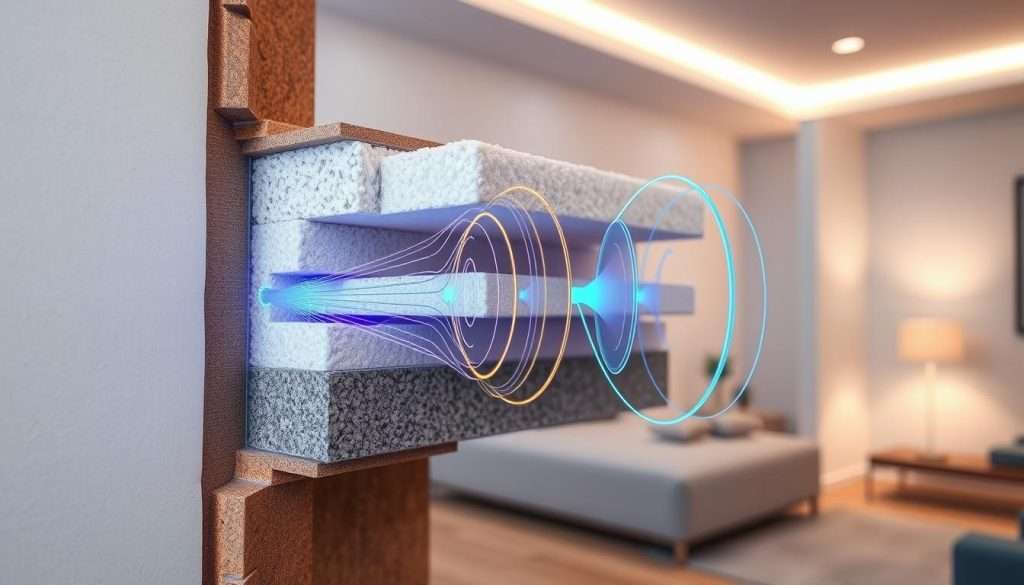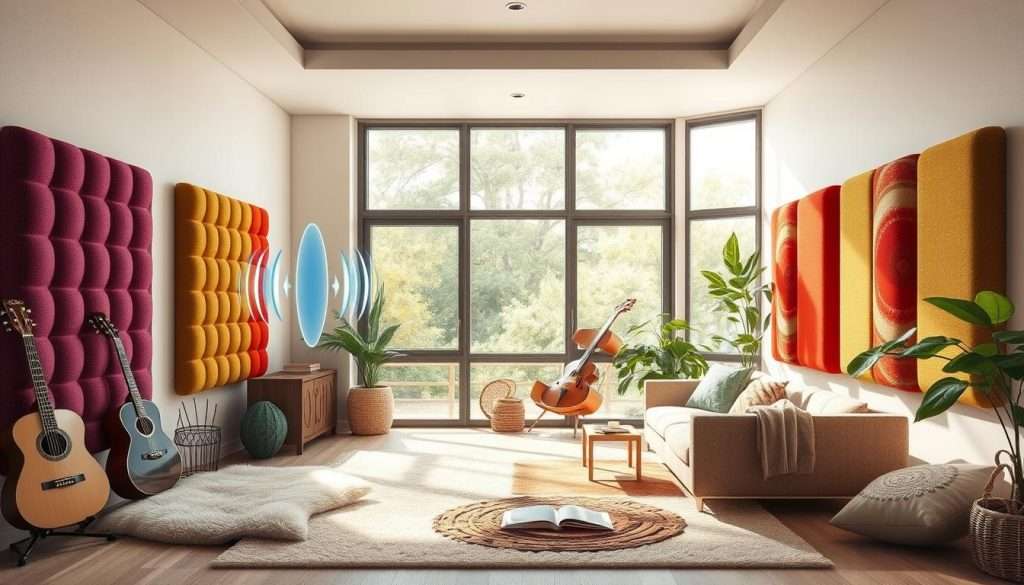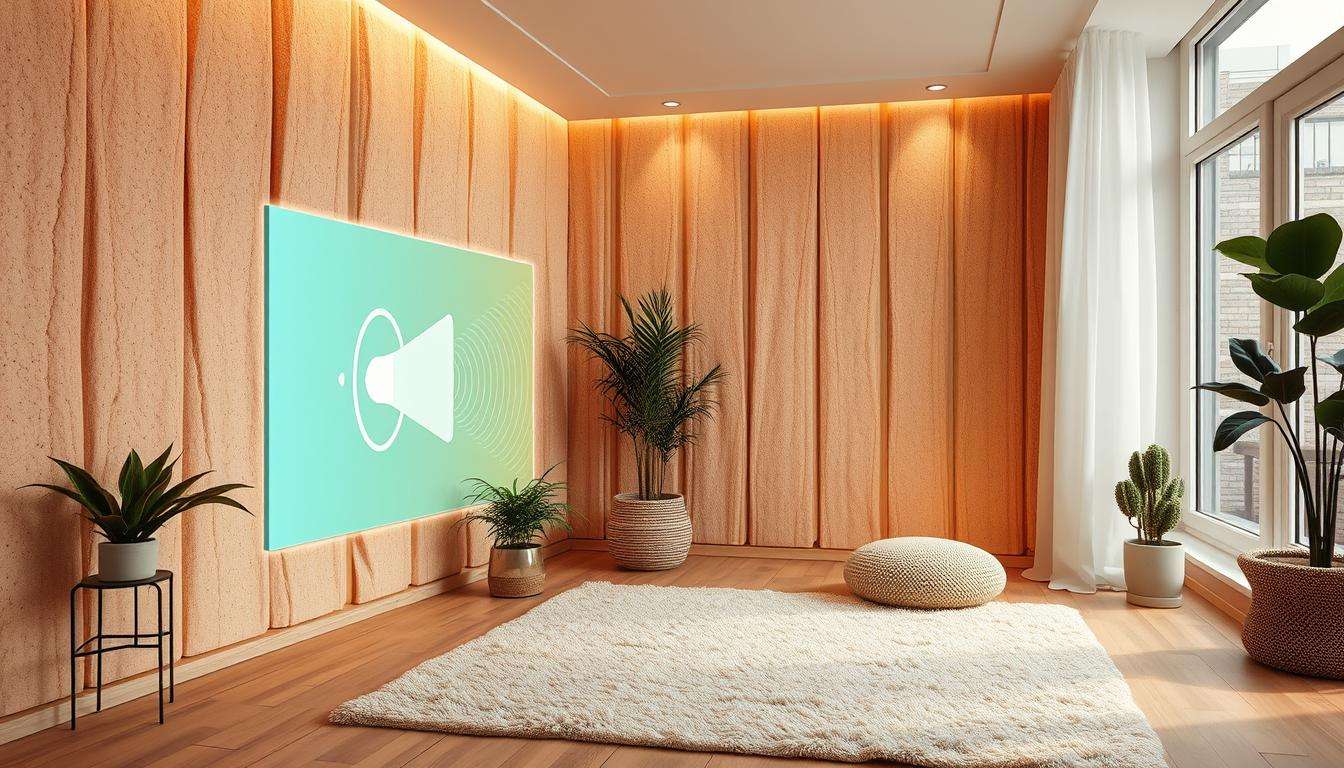Noise pollution is a big problem in cities today. Many people ask: does insulation help with sound? Yes, it does. Soundproofing insulation makes your home quieter by blocking out traffic, construction, and neighbor noise.
This guide will cover how insulation works for sound dampening. We’ll talk about the different types, their effectiveness, and how to install them. If you want a quieter home, knowing about sound transmission and insulation is key.
Key Takeaways
- Insulation creates a barrier that reduces noise transmission between rooms.
- Denser materials provide better sound absorption and blocking.
- Sound Transmission Class (STC) ratings indicate insulation effectiveness in soundproofing.
- Proper installation and sealing air gaps are crucial for optimal soundproofing results.
- Fiberglass insulation is commonly used, but options like mineral wool offer enhanced soundproofing capabilities.
- Consulting professionals can help you choose the right materials for your soundproofing needs.
Understanding Sound Transmission
Sound transmission is key to solving noise problems. It’s how sound moves from one place to another, causing unwanted noise. Knowing this helps homeowners make their homes quieter.
What is Sound Transmission?
Sound transmission is when sound waves move from one area to another. These waves can travel through air or solid things. Walls, ceilings, floors, doors, and windows block sound differently.
They are rated by Sound Transmission Class (STC). STC ratings range from 25 to over 60. Lower ratings mean less noise blocking, and higher ratings mean better soundproofing.
The Science Behind Sound Waves
Sound waves have two main parts: frequency and amplitude. Frequency is the sound’s pitch, and amplitude is its volume. High-frequency sounds, like voices, act differently than low-frequency sounds, like bass.
This difference affects how well sound can be blocked. For example, a basic wall might block sound poorly, with an STC of 33. But a well-made wall with special materials can block sound much better, with an STC of 62.
Transmission Loss (TL) shows how sound volume changes on either side of a wall. But STC ratings have limits, especially for low-frequency noises. Knowing this helps people deal with noise problems at home.
Types of Insulation for Soundproofing
Choosing the right insulation is key to quieting your home. Different materials help block noise. Here are some popular ones:
Fiberglass Insulation
Fiberglass is common in homes and offices. It comes in batts and blown-in forms. It’s good at soaking up sound.
It’s also safe from fire and water. But, blown-in fiberglass is better for sound than batts. It’s a good choice for more soundproofing.
Foam Board Insulation
Foam board is for outside walls. But, it doesn’t block sound well. It’s better for keeping warm than quiet.
Cellulose Insulation
Cellulose is green, made from recycled stuff. It’s packed tightly for better sound blocking. It needs a special layer to keep dry.
| Insulation Type | Sound Absorption | Moisture Resistance | Installation Ease |
|---|---|---|---|
| Fiberglass Batt | Moderate | Good | Easy |
| Blown-in Fiberglass | Good | Good | Moderate |
| Foam Board | Poor | Good | Easy |
| Cellulose | Excellent | Needs Vapor Barrier | Moderate |
Choosing the right insulation is crucial for your home’s sound. Fiberglass, foam, or cellulose each has its own strengths. Knowing these helps you pick the best for sound reduction and comfort.
How Insulation Reduces Noise
Insulation helps make your home quieter. It absorbs sound and stops vibrations. This tackles different noises well.
Airborne vs. Impact Noise
There are two kinds of sound: airborne and impact. Airborne sounds come from things like traffic and appliances. Impact noises are from vibrations, like footsteps.
To block sound well, you need the right insulation. For example:
- Fiberglass insulation is good and not too expensive.
- Mineral wool insulation lasts long and absorbs sound well.
- Cellulose insulation is made from recycled paper and blocks noise well.
- Foam board insulation blocks sound, especially with thicker boards.
Decibel Levels Explained
The Sound Transmission Class (STC) rating shows how well insulation blocks sound. A higher STC means better sound blocking. Here’s a quick look:
| Insulation Type | STC Rating | Notes |
|---|---|---|
| Fiberglass Insulation | up to 30 | Moderate sound absorption, budget-friendly. |
| Mineral Wool Insulation | up to 40 | Highly resistant to damage and effective at sound deadening. |
| Cellulose Insulation | up to 35 | Excellent for both noise and thermal insulation. |
| Foam Board Insulation | up to 32 | Available in various thicknesses for enhanced sound blockage. |
| Spray Foam Insulation | up to 36 | Forms airtight seals, blocking a wide range of sounds. |
In short, the right insulation makes your home quieter. It blocks both airborne and impact noises. This makes your home a quieter place to live.

Benefits of Soundproof Insulation
Choosing the right insulation can make your home better. It’s not just about blocking noise. It’s about making your home a peaceful place.
Improved Privacy
Soundproof insulation keeps noise from moving between rooms and outside. This means you can have peace without outside noise. Your home becomes a quiet place where you can relax.
Enhanced Comfort
Too much noise can make you stressed and distracted. Good insulation makes your home quieter. It also helps keep your home warm or cool, making it more comfortable.
| Type of Insulation | Effectiveness in Noise Control | Energy Efficiency Contribution |
|---|---|---|
| Acoustic Foam Panels | High | Moderate |
| Acoustic Blankets | Moderate | Moderate |
| Mass Loaded Vinyl (MLV) | Very High | Low |
Learn more about soundproofing and insulation here. The right insulation can turn your home into a peaceful place. It can make your life better.
Comparing Insulation Materials
Choosing the right insulation for soundproofing is key. You need to think about R-Value and cost. R-Value helps with keeping warm but also blocks sound. Materials with higher density block sound better.
It’s important to balance R-Value with sound blocking. Knowing about different materials helps you decide. This way, you can pick the best option for your budget and sound needs.
R-Value and Soundproofing
R-Value is important for insulation. Here are some points to remember:
- Blown-in fiberglass insulation has an R-Value of 3.1 to 4.3 per inch.
- Fiberglass batts have similar R-Values but block sound less at 36 STC.
- Closed cell spray foam blocks sound well at 41 STC.
- Blue jean denim insulation blocks sound at 45 STC, is eco-friendly, and good for noise.
- Rock wool batt insulation has a high STC rating of 50.
Cost vs. Effectiveness
Cost matters when choosing insulation. Prices vary a lot. Here’s a table showing costs and STC ratings:
| Insulation Material | Cost per Square Foot | STC Rating |
|---|---|---|
| No insulation barrier | $0 | 0 |
| Blown-in fiberglass insulation | $0.5 – $3.0 | 36 |
| Batts of fiberglass insulation | $0.5 – $1.5 | 36 |
| Closed cell spray foam insulation | $1.2 – $4.0 | 41 |
| Blue jean denim insulation | $1.6 – $2.6 | 45 |
| Rock wool batt insulation | $1.3 – $2.0 | 50 |
| Open cell spray foam insulation | $0.4 – $2.0 | 50 |
Higher STC ratings cost more but save more in the long run. They reduce sound and save energy. By looking at these options, you can pick the best insulation for your home. This will make your home more comfortable and quiet.
Installation Techniques for Soundproofing
Understanding how to soundproof your home is key. You can do it yourself or get a pro. Each way has its own perks, letting you pick what works best for you.
Do-It-Yourself Methods
If you like fixing things around the house, you can try some DIY soundproofing. Here are a few ways to do it:
- Fill wall cavities with batt or blown-in insulation to block sound better.
- Use drywall and acoustic caulk to make a tight seal, cutting down on noise.
- Put up acoustic foam panels to soak up sound in any room.
- Heavy furniture, bookshelves, and wall art can also help absorb sound and cut down on echo.
Professional Installation Options
For the best results, getting a pro is a smart move. They’re great for tricky spots or big projects. Here’s what they can do:
- They’ll give you advice on the right materials for your space and how to install them.
- They’ll check your rooms to make sure they meet sound quality standards.
- They can install special barriers and products to block sound even better.
- They’ll also tell you how to seal gaps in windows and doors for better soundproofing.
Whether you DIY or get a pro, soundproofing works well with the right insulation and careful installation.
Common Mistakes in Soundproofing
Soundproofing needs careful planning and doing. Mistakes can ruin your efforts, making insulation less effective. It’s key to know common errors to get the best results.
Ignoring Air Gaps
Many people forget about air gaps. These gaps are in walls, ceilings, and floors. They let sound in, even small ones.
Sealing these gaps with caulk or tape helps a lot. It makes your soundproofing better.
Overlooking Windows and Doors
Windows and doors are often missed in soundproofing. They can let a lot of noise in if not sealed well. Using solid-core doors and weather stripping helps a lot.
Other Common Soundproofing Errors
- Not picking the right materials: Stuff like cardboard and paint don’t work well.
- Forgetting about floors and ceilings: Sounds can bounce off, so these areas need attention too.
- Not knowing the difference between sound types: Airborne sounds need different solutions than impact noise.
- Believing marketing over lab tests can lead to bad choices in soundproofing products.
| Common Mistakes | Impact on Soundproofing |
|---|---|
| Ignoring air gaps | Reduces overall soundproofing effectiveness |
| Overlooking windows and doors | Allows significant noise penetration |
| Choosing ineffective materials | Fails to provide sound reduction |
| Neglecting specific needs for sound types | Results in underperformance |
Soundproofing Other Areas of Your Home
Many parts of your home can get quieter with soundproofing. It makes your living space better. Look at basements, attics, walls, and ceilings. They all help block noise.
Basements and Attics
Basements get noise from outside or neighbors. Use insulation like fiberglass to cut down on this noise. Attics can also let sound in, so they need insulation too.
Walls and Ceilings
Walls and ceilings are key for keeping noise in or out. Use materials like mineral wool or spray foam to block sound. For tricky spots, get a pro to install it right.
| Soundproofing Area | Recommended Materials | Benefits |
|---|---|---|
| Basements | Fiberglass, Cellulose | Minimizes external noise |
| Attics | Mineral Wool, Spray Foam | Prevents sound leakage into living spaces |
| Walls | Fiberglass, Mineral Wool | Reduces noise between rooms |
| Ceilings | Spray Foam, Cellulose | Lowers noise transfer from upper floors |
Using these tips and materials will make your home quieter. It’s a big step towards peace. But remember, it might not stop all noise, especially in busy areas. Try sound-absorbing panels and thick carpets for more quiet.
Evaluating Your Surroundings
It’s important to know what’s making noise around you. Start by finding out where the noise is coming from. This helps you choose the best way to block out sounds.
Things like traffic, neighbors, and even your own appliances can be noisy. Knowing what’s causing the noise lets you pick the right materials or methods to use.
Identifying Noise Sources
To deal with noise, follow these steps:
- Walk around your home and listen for disturbing sounds.
- Note the time of day when noises are most prevalent.
- Check for common culprits such as windows, doors, and existing insulation materials.
Knowing what kind of noise you’re dealing with helps a lot. It tells you what kind of insulation you need to block out sounds.
Assessing the Need for Insulation
Checking your insulation is the first step to see if you need more. Here are some things to think about:
- Inspect current insulation material quality for effectiveness in sound control.
- Examine areas like walls, ceilings, and floors for any gaps or weak points that may allow sound leakage.
- Consider the costs and benefits of professional soundproofing options versus DIY methods.
Often, you need both soundproofing and insulation to really quiet things down. Getting the right soundproofing can make your home quieter and more valuable. It’s all about knowing what you need to make your space quieter.

Final Thoughts on Insulation and Sound
Soundproofing your home with the right insulation can make it quieter. This might cost a lot at first. But, it saves money in the long run by lowering energy bills and making your home more comfortable.
Cost Considerations
Think about how a quieter home is more appealing to buyers. Using thicker drywall with Green Glue can really help. But, some methods might make noise worse if not done right.
Long-Term Benefits
Good insulation makes your home quieter and more valuable. A 25% drop in sound pressure feels like half as loud. So, picking the right insulation and how to install it makes your home more welcoming. You’ll enjoy peace and quiet for many years.
